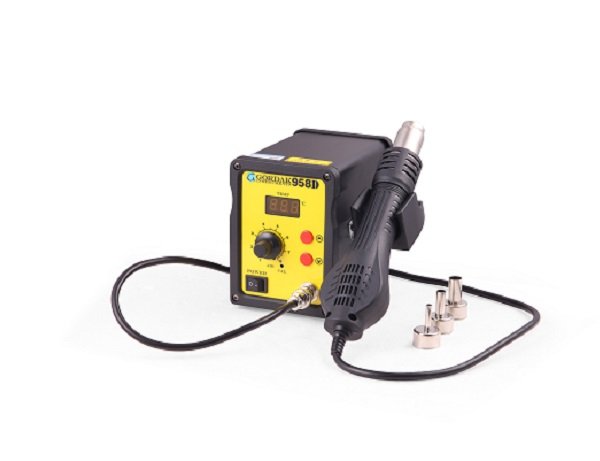Hot air rework stations are essential tools in modern electronics repair and assembly, especially for working with surface-mounted devices (SMDs). While powerful and precise, these tools must be used correctly to ensure both effective results and operator safety. Whether you’re a first-time user or just looking to refine your skills, this guide will walk you through the best practices for using a hot air rework station safely and effectively.
At Gordak Electric, we are committed to providing not only high-quality rework stations but also practical guidance to help our customers operate them with confidence.
Why Safety Matters
Hot air rework stations operate at high temperatures, often between 100°C and 500°C. Improper use can lead to:
- Damage to sensitive electronic components
- Burns or other personal injury
- Fire or smoke hazards
- Poor-quality soldering or desoldering results
Following proper procedures protects both your equipment and your workspace while ensuring professional outcomes.
Step-by-Step Guide for Beginners
1. Set Up in a Well-Ventilated Workspace
Ensure your work area is clean, organized, and properly ventilated. Solder fumes, especially those from flux, can be harmful if inhaled. Consider using a fume extractor for added safety.
2. Power On and Adjust Settings
Turn on the hot air rework station and set the appropriate:
- Temperature: Most SMD tasks require temperatures between 260°C and 350°C.
- Airflow: Adjust to low or medium to prevent lifting nearby components or damaging the PCB.
If you’re using a Gordak Electric station, follow the operation manual for exact setup instructions specific to your model.
3. Choose the Correct Nozzle
Select a nozzle that matches the size of the component you’re working on. A well-fitted nozzle provides precise heat and avoids affecting surrounding parts.
4. Preheat the PCB (Optional but Recommended)
Preheating the PCB can help reduce thermal shock, especially when working on multi-layer or heat-sensitive boards. This step also promotes uniform heat distribution.
5. Apply Heat with Controlled Movement
Hold the hot air gun at a 2–4 cm distance from the board. Move it in small circular motions over the component to evenly distribute heat. Avoid holding it in one spot for too long, as this may overheat the board or component.
6. Use ESD-Safe Tools
When removing or repositioning components, use anti-static tweezers or vacuum pens to avoid electrostatic discharge (ESD), which can damage microelectronics.
7. Turn Off the Station Safely
After finishing your work:
- Turn off the heat but allow the airflow to continue for a short time to cool the heating element.
- Place the hot air gun back in its holder.
- Once fully cooled, power off the station completely.
Gordak rework stations are designed with intelligent cooling systems that extend equipment life and ensure safe shutdown.

Additional Safety Tips
- Never touch the nozzle while in use or immediately after use — it remains extremely hot.
- Keep flammable materials away from your work area.
- Avoid overheating components, which can lift pads or cause delamination.
- Always wear safety glasses to protect your eyes from accidental splashes of molten solder or debris.
Training and Practice
If you’re new to using a hot air rework station, practice on old or discarded circuit boards before working on valuable devices. This allows you to get comfortable with temperature control, nozzle movement, and timing.
Why Choose Gordak Electric
At Gordak Electric, we design and manufacture advanced hot air rework stations trusted by professionals worldwide. Our models are equipped with:
- Precise temperature and airflow control
- Stable heating performance
- Safety-focused designs for long-term durability
- User-friendly operation for beginners and experts alike
For support, product recommendations, or OEM/ODM cooperation, please feel free to contact us.
Email: info@gordakelec.com
Hot Air Rework Stations
What Is a Hot Air Rework Station and How Does It Work?
Applications of a Hot Air Rework Station: What Can Be Soldered?
Hot Air Soldering for BGA and SMD Repair
Hot Air Rework Station vs. Infrared Rework Station: Pros and Cons
Analog vs. Digital Hot Air Rework Stations: What’s the Difference?
Using a Hot Air Rework Station for Mobile Phone Repairs
Can You Use a Hot Air Rework Station for Heat Shrink Tubing?
Hot Air Reflow Soldering: What It Is and How It Works
Hot Air Rework Station Maintenance Guide
Troubleshooting Common Hot Air Soldering Issues
Tips to Prevent PCB Damage While Using a Hot Air Rework Station
Beginner’s Guide to Using a Hot Air Rework Station Safely
How to Desolder SMD Components Using a Hot Air Rework Station



